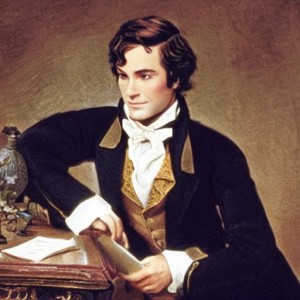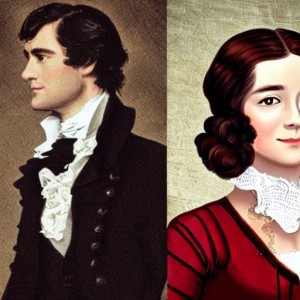First published in 1813, Pride and Prejudice is considered one of the best and most influential of Jane Austen’s novels. It inspired countless adaptations and reinterpretations over the years and is a classic example of a romantic novel of manners. It provides its readers with a unique glimpse into the intimate lives of the upper classes of the early 19th-century English society. Even though it is set in a time very different from our own, its main themes remain relevant even two centuries later.
Set in Hertfordshire and Derbyshire around the beginning of the 19th century it tells the story of the Bennet family with its five daughters, the second eldest of whom – Elizabeth is the focus of the story. The Bennet sisters are very different from each other and strongly characterized in the novel to provide contrast to Elizabeth’s intelligence and wit. The eldest daughter – Jane is very pretty and sweet, Mary is judgemental and disagreeable, Kitty is an airhead and the youngest – Lydia is completely devoured by her obsession with men and has little interest in anything else.
Like in many Austen novels, the question of inheritance and money is raised very early on. The main problem is that Mr. Bennet doesn’t have a son. His death will mean that his daughters will not inherit anything from him and will be left with very poor means to support themselves. It is therefore of vital importance that the daughters marry well while they are still young and pretty, or so their mother thinks.
The story begins with some exciting news. An eligible bachelor Mr. Bingley has just moved in close by. Hearing of his fortune, Mrs. Bennet immediately decides to act and push one of her daughters at him before he is snatched by another girl. The entire family is soon invited to a ball and Mr. Bingley is immediately attracted to the eldest Bennet sister – Jane, with whom he dances twice. During the same ball, Elizabeth is acquainted with Mr. Bingley’s best friend – Mr. Darcy, who is cold and aloof and refuses to dance with her. As the novel progresses, he regrets this decision as he finds himself drawn to her but by that time it is too late to change her first impression of him. The back and forth between the characters, filled with plenty of frustration on both sides becomes the driving force of the novel.
As Jane’s romance with Mr. Bingley blossoms, two more men enter the Bennets’ lives. First, Mr. Collins, a pompous clergyman, who is a cousin of the family and, as the closest male relative to Mr. Bennet, is set to inherit his estate. He comes to visit them to marry one of the daughters and when he learns that Jane is in love with Mr. Bingley, he sets his sights on Elizabeth who is far from happy about this development. The second man is a dashing army officer – George Wickham who is also interested in Elizabeth and whom she is attracted to. Their bond soon strengthens even more as he learns about her dislike of Mr. Darcy – a man he blames for depriving him of an occupation. As the plot develops the reader learns of the true nature of George Wickham, however. He ends up seducing Elizabeth’s younger sister Lydia – a conundrum which only an intervention from Mr. Darcy solves.
The relative poverty of the Bennets also plays a major role as the romance between Elizabeth and Mr. Darcy develops and his rich aunt – Lady Catherine intervenes asking her not to accept his proposal. She also tries to break up the relationship between Jane and Mr. Bingley, as she deems the Bennets to be a highly undesirable family to be married into.
Like all Jane Austen novels, Pride and Prejudice meanders around many themes as it leads to the happy ending for its characters. Gender is one of the most important ones. The Bennet sisters, as all women at that time, live with the knowledge that they have a very limited ability to decide about their own lives and support themselves if they cannot find a husband. This theme was vital to the author herself, as she struggled all her life to manage without marrying a man to provide for her. But she was one of the very few who did that.
Love is, of course, another very strong theme in the novel. Marrying for love was not the rule for the English upper classes, so both Jane and Elizabeth were very lucky to have married the men they loved. Charlotte, Elizabeth’s friend, who in the end marries the absurd Mr. Collins is an example of a different, more pragmatic approach to the question of marriage. She calculates her decision carefully and marries him for money, knowing very well that her options are limited. Elizabeth doesn’t understand this decision as she wants her happiness to outweigh her need for financial security, but Charlotte merely does hat most women did at the time.
The eponymous “Pride and Prejudice” play a vital role in Jane Austen’s work as well. It is the prejudice that doesn’t allow Elizabeth to look beyond the aloof nature of Mr. Darcy when she first meets him. She can be judgemental and very rigid in her convictions and so can he. But it’s pride that is his most important vice and it is pride that doesn’t allow him to start the relationship with Elizabeth well. This pride almost causes him to lose her and it is only after they both realize the error of their ways that they can see each other in a different light.
Jane Austen used her book to critique the rigid society she was part of. Thanks to her wit and observant nature she was able to describe the world she was living in with an effect that is still striking to the modern reader. Even though the world has changed so much that Jane Austen wouldn’t have recognized it, the timeless message of the novel is still relevant today. First impressions matter. Pride can lead to prejudice and in turn, cause us to close our eyes and hearts to others.

